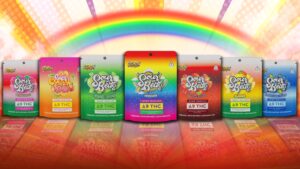With at least 113 known cannabinoids and more potentially yet undiscovered, the future of cannabis tech and science holds exciting promise. Cannabicyclol or CBL is one of the less understood cannabinoids, but it may have some properties that closely resemble others that are more well known.
Cannabis is a multi-purpose plant with more and more uses discovered all the time. From a taboo drug to a medicinal powerhouse, cannabis science is uncovering therapeutic benefits that have the potential to revolutionize plant-based medicine and disrupt the pharmaceutical industry. Let’s dive into what CBL is all about.
What is CBL (Cannabicyclol)?
CBL, or cannabicyclol, is a cannabinoid found in cannabis. It is considered a minor cannabinoid. It doesn’t produce any intoxicating effects — unlike THC (tetrahydrocannabinol), the abundant cannabinoid found in marijuana.
Much like delta-8 THC is a degraded form of delta-9 THC, CBL is formed when CBC (cannabichromene) degrades. This can happen simply by aging, or by exposure to UV lights and repeated exposure to oxygen. Since CBL is present in such small quantities, it remains largely understudied.
CBD vs. CBL: What Are the Differences?
Both CBD (cannabidiol) and CBL are cannabinoids found in cannabis. Hemp and marijuana (with cannabis being the mother plant to both species) contain vast networks of cannabinoids, though there are some noticeable differences in percentages. Marijuana contains higher percentages of THC, while hemp contains higher ratios of CBD. In regards to CBL, concentrations are pretty low in all observed cannabis plants to date.
What Does CBL Do?
What we do know about CBL is it is similar in structure to other non-intoxicating cannabinoids, such as CBD, CBG (cannabigerol), and CBN (cannabinol). The similarities lead researchers to believe that it may offer the same therapeutic benefits and have medicinal properties when consumed in significant amounts.
Furthermore, it may also contribute to the entourage effect. This phenomenon occurs when cannabinoids, terpenes, flavonoids, and other naturally occurring compounds in the cannabis plant work together synergistically to provide maximum benefits the plant has to offer.
Does CBL Get You High?
CBL does not have the same double-bond molecular structure that other intoxicating cannabinoids do and will not get you high. However, as it engages the entourage effect, it may help enhance the impact of intoxicating cannabinoids like THC.
Will CBL Cause You To Fail A Drug Test?
Without further study, this is a complex question. What we do know is that most standardized drug tests are only designed to test for THC metabolites. The problem is that cannabinoids are broken down into metabolites, and unfortunately, these tests are not sophisticated enough to determine a cannabinoid’s origin.
Even people who consume only CBD products can fail a THC test due to the residual trace amounts of THC present. Without further study, it is better to play it safe and assume that any cannabinoid may result in a failed THC drug test when taken for long periods or in large quantities.
What Are the Therapeutic Properties of CBL?
Without further study, the full potential benefits of CBL remain unknown. Suppose CBL does, in fact, produce similar effects as CBD, CBG, and CBN. In that case, we can assume that it might help with appetite stimulation, pain relief, improved sleep quality, reduced anxiety, and decreased inflammation. As of now, CBL has the lowest biological activity of all researched cannabinoids.
Is CBL Legal?
CBL is not scheduled under the Convention on Psychotropic Substances. However, as research develops, CBL will likely be regulated like other non-intoxicating cannabinoids. For example, there are many ways to use CBD so long as it contains less than 0.3% THC.
What Benefits is CBL Most Commonly Used For?
Aside from understanding the molecular structure of CBL, scientists are unsure what kind of health benefits it can provide. However, we are hopeful for the discovery of more positive properties to emerge as research continues.
What are the Most Common Side Effects of CBL?
No known side effects currently exist for CBL, though it may possess common side effects associated with other cannabinoids. These include dry mouth, drowsiness, nausea, vomiting, and mild paranoia. However, as with all cannabis products, these side effects are often mitigated by starting slowly with a small dose and increasing only once full effects have been evaluated.
Why is CBD More Popular Than CBL?
CBD has a hefty amount of research touting its uses and benefits. CBD is a readily available cannabinoid found in food, body care products, supplements, and common household items. Hemp-derived CBD is legal for use and easy to obtain through extraction. Until CBL is more understood, CBD will remain the most notable of the non-intoxicating cannabinoids.
What Are the Most Common Types of CBL Products?
As of now, CBL has not been isolated and concentrated to be included in cannabis products. As research grows and strains with ample CBL are discovered, we will likely see more focus on CBL dominant products.
How Long Does CBL Take to Work?
As with most cannabinoids, the method of consumption will affect how long it takes for effects to kick in. Smoking and vaporizing tend to produce the quickest results, taking effect within minutes. Tinctures work quickly by engaging the sublingual delivery.
Typically, tinctures are highly concentrated and only a few drops are placed under the tongue where the active properties are absorbed through the mouth’s soft tissues. Cannabis edibles take longer, as they need to pass through the digestive system before entering the bloodstream. You can expect initial effects within 30 minutes, but full effects can take up to two hours.
How Long Do the Effects of CBL Last?
If CBL behaves like other minor cannabinoids, the effects will vary based on each individual, dosage, and consumption method. As a general rule, smoking and vaping may produce effects for anywhere from two to four hours. Edibles have the most prolonged duration and can last for up to six to eight hours for some users.
Are There Any Drug Interactions with Cannabicyclol?
Until more research is released, it’s unclear if CBL will have any drug interactions.
Where Can You Buy CBL?
Once available, CBL products will probably be available in many online retailers or dedicated cannabis dispensaries.
How Old Do You Have to Be to Buy CBL?
As with any cannabinoid product, you must be 21 to purchase. However, many states have a medical marijuana program that allows patients under 21 to purchase cannabis products with their medical card. This may be the case with future CBL products.
How Do You Know Your CBL Is High Quality and Reputable?
When it comes to shopping for high-quality cannabis products, always look for test results. If the product does not provide access to third-party laboratory testing, it is likely not reputable.


